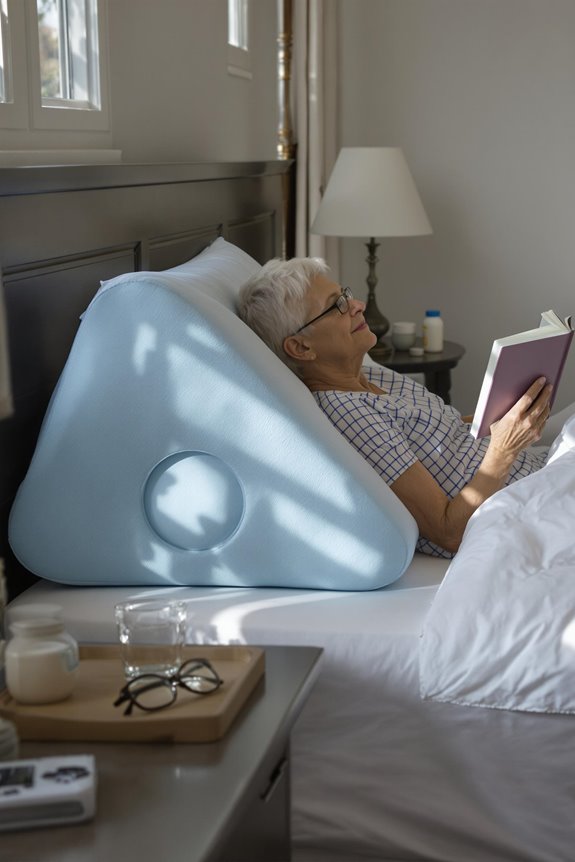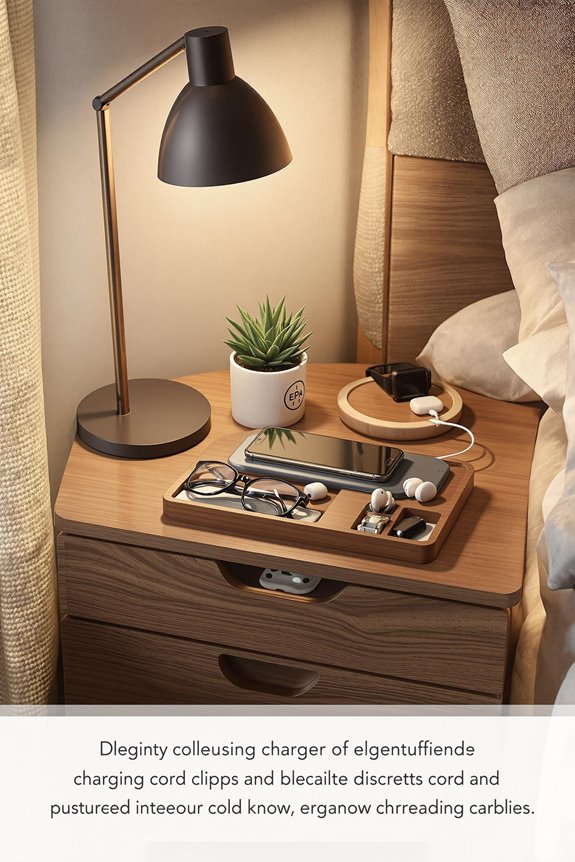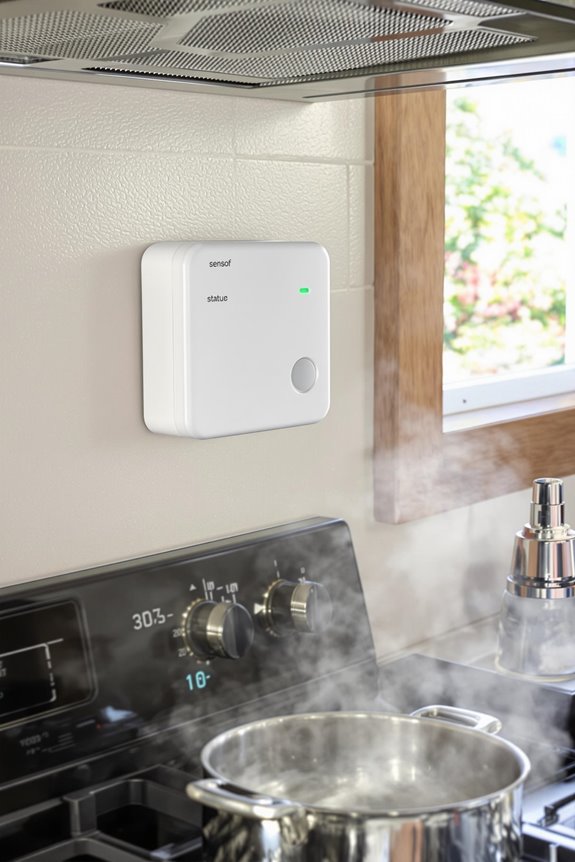When you face mobility challenges, even simple bathroom tasks can become intimidating hurdles. Raised toilet seats offer an immediate solution to this common problem, elevating the sitting surface by 2-6 inches to reduce strain on your knees, hips, and back during transfers. You’ll experience greater independence and considerably lower your risk of falls—a vital benefit considering bathroom accidents account for thousands of injuries annually. But which type best suits your specific needs?
Key Takeaways
- Raised toilet seats increase sitting height by 2-6 inches, significantly reducing strain during bathroom transfers.
- Installation options include tool-free clamp-on models and more stable bolt-on versions for quick setup.
- Features like padded seats and built-in handles provide additional comfort and stability during transfers.
- Regular maintenance ensures continued stability with weekly checks on fasteners to prevent accidents.
- Weight capacities range from 250-350 pounds for standard models, with bariatric options supporting up to 600 pounds.
Raised Toilet Seats
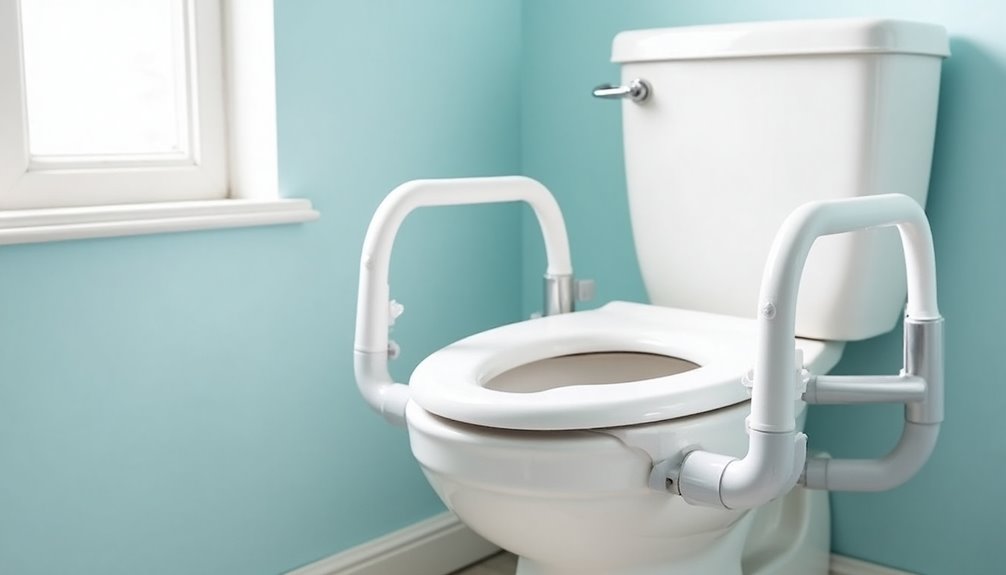
Independence and dignity often start with the simplest adjustments in our daily routines. For seniors aging in place, raised toilet seats provide both comfort and accessibility while greatly reducing fall risk during transfers.
Small changes create big independence. Raised toilet seats offer seniors dignity and safety in their daily routines.
The best options add 3-5 inches of height, making standing and sitting easier for those with mobility challenges.
When choosing raised toilet seats for your parents, consider installation requirements—some clamp on temporarily while others replace the existing seat.
Placement is essential; make certain it’s securely attached with no wobbling. Costs typically range from $25 for basic models to $150 for premium options with armrests.
For maximum home safety and fall prevention, look for models with non-slip surfaces, secure locking mechanisms, and weight capacities that accommodate your loved one comfortably. Additionally, ensuring that the raised toilet seat is part of a comprehensive medication management program is vital for overall health and safety in assisted living environments.
What it is and the daily problems it solves
Everyday mobility challenges can become significant hurdles for seniors, particularly when using the bathroom. A raised toilet seat is an adaptive device that attaches to existing toilets, increasing the sitting height by 2-6 inches, making transfers safer and more accessible.
This simple solution addresses multiple daily problems: reducing the strain of sitting down and standing up, minimizing fall risks during transfers, and increasing independence for those with limited mobility, recent surgeries, or conditions like arthritis.
It helps bridge the gap between standing and sitting positions, requiring less knee flexion and upper body strength. For many seniors, these devices transform a once-challenging necessity into a manageable task, allowing them to maintain dignity and self-sufficiency in their personal care routine.
Who benefits and when to use it
Many seniors and individuals with specific mobility concerns can benefit from raised toilet seats, creating safer bathroom experiences.
These adaptive devices are particularly helpful for anyone recovering from hip or knee surgery, those with arthritis, individuals with balance issues, or seniors who find it difficult to lower themselves to standard toilet height.
Consider installing a raised toilet seat when your loved one struggles with bathroom independence, experiences pain when sitting or standing, or if you notice they’re avoiding using the bathroom due to difficulty.
The right time to introduce this modification is before a crisis occurs – ideally as a preventative measure when you first notice minor struggles with transfers.
This simple solution can maintain dignity and independence while reducing fall risks substantially.
Key features to look for
When shopping for a raised toilet seat for your parent, certain features can make a huge difference in comfort, safety, and ease of use.
Looking at the right specifications will help you find a model that fits both the bathroom setup and your loved one’s specific needs.
Let’s explore what features matter most to guarantee you’re making the best possible investment in your parent’s daily independence.
Feature checklist
Selecting the right raised toilet seat for your parent involves considering several essential features that affect comfort, safety, and usability.
When shopping for this important bathroom modification, keep this checklist handy to guarantee you’re getting the most appropriate option for their specific needs.
- Weight capacity – Verify it supports your parent’s weight with at least a 50-pound buffer for safety.
- Installation method – Choose between clamp-on models (no tools required) or bolt-on versions (more permanent, greater stability).
- Height increase – Select from 2-6 inch options based on mobility challenges and comfort needs.
- Additional features – Consider models with padded seats, handles, or backs depending on balance and comfort requirements.
Remember that the best choice balances ease of use with the specific physical limitations your parent faces.
How to choose the right raised toilet seats
Choosing the right raised toilet seat for your parent requires careful consideration of their specific mobility needs and bathroom setup.
When selecting a model, focus on height increase (typically 2-5 inches), weight capacity, installation method, and stability features.
Measure the distance between your parent’s knee and hip while seated to determine ideal height. For those with limited hand strength, look for models with minimal assembly and secure locking mechanisms.
For bathrooms used by multiple people, removable models offer flexibility, while permanent installations provide maximum stability for those with significant balance concerns.
Always check that the seat fits your specific toilet shape—elongated or round—and consider models with armrests if your parent struggles with standing independently.
Padded options offer additional comfort for those with sensitivity issues.
Placement or installation basics
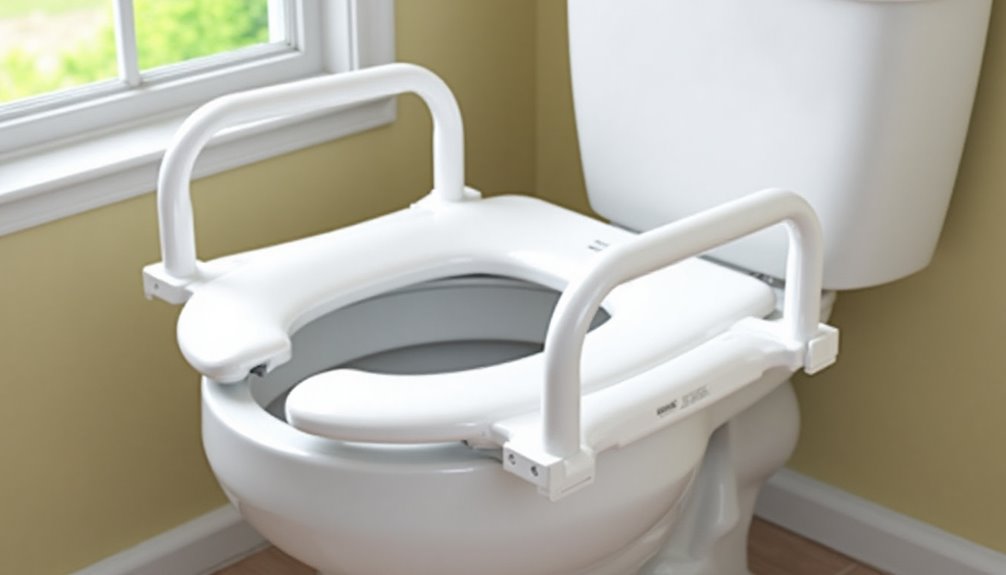
Now that you’ve found the right raised toilet seat, proper installation is your next step for guaranteeing your parent’s safety. Most models fall into two categories: those that clamp onto the bowl and those that replace your existing toilet seat.
Proper installation isn’t just about convenience—it’s the key safeguard for your parent’s continued independence in the bathroom.
For clamp-on models, verify the toilet bowl is clean before attaching. Position the seat squarely on the bowl, then tighten the adjustment knobs or brackets until secure. Test by pressing firmly on all sides—there should be no movement.
For replacement seats, remove the existing toilet seat by unscrewing the bolts underneath. Position the new raised seat over the mounting holes and insert the provided hardware. Tighten gradually on both sides to prevent cracking or uneven pressure.
Always check for stability before first use. If you notice any wobbling after installation, immediately readjust the attachments.
Setup steps
Once you’ve properly installed the raised toilet seat, setting up the surrounding area guarantees your parent can use it safely and comfortably.
Create a clear path to the toilet, removing any rugs that could cause trips or slides.
Install grab bars at the proper height—usually 33-36 inches from the floor—on both sides of the toilet, making sure they’re anchored securely into wall studs.
Place a small table or shelf within easy reach to hold essentials like tissues, wipes, and hand sanitizer.
If possible, add a waterproof call button or phone nearby for emergencies.
Finally, verify good lighting with motion-activated night lights to eliminate fumbling for switches in the dark.
Test everything with your parent present, watching for any difficulties that might require adjustments to your setup.
Costs and warranties
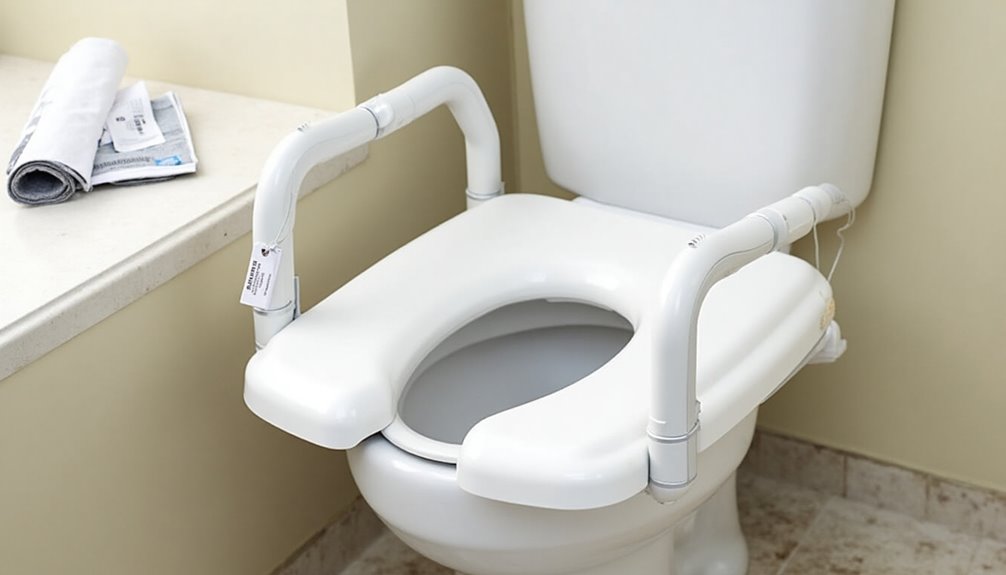
Let’s explore what you can expect to budget for a raised toilet seat for your parents.
Most basic raised toilet seats cost between $25-$75, while models with armrests or other features typically range from $80-$150.
Premium options with height adjustment capabilities or specialized support features may run $150-$300, depending on their construction and additional functionality.
Example budget
Understanding the potential costs involved in purchasing a raised toilet seat will help you budget appropriately for this important accessibility modification. While prices vary based on features and quality, I’ve created a sample budget to guide your planning process.
| Item | Estimated Cost |
|---|---|
| Basic raised seat | $25-$45 |
| Padded raised seat | $35-$60 |
| Raised seat with arms | $40-$80 |
| Hinged raised seat | $70-$120 |
| Installation help (if needed) | $50-$100 |
Most families find that spending between $30-$80 provides a good balance of comfort and safety. Remember to factor in potential shipping costs if ordering online. Many insurance plans don’t cover these items, but they may qualify as medical expenses on your tax return, so save your receipts.
Daily use and upkeep
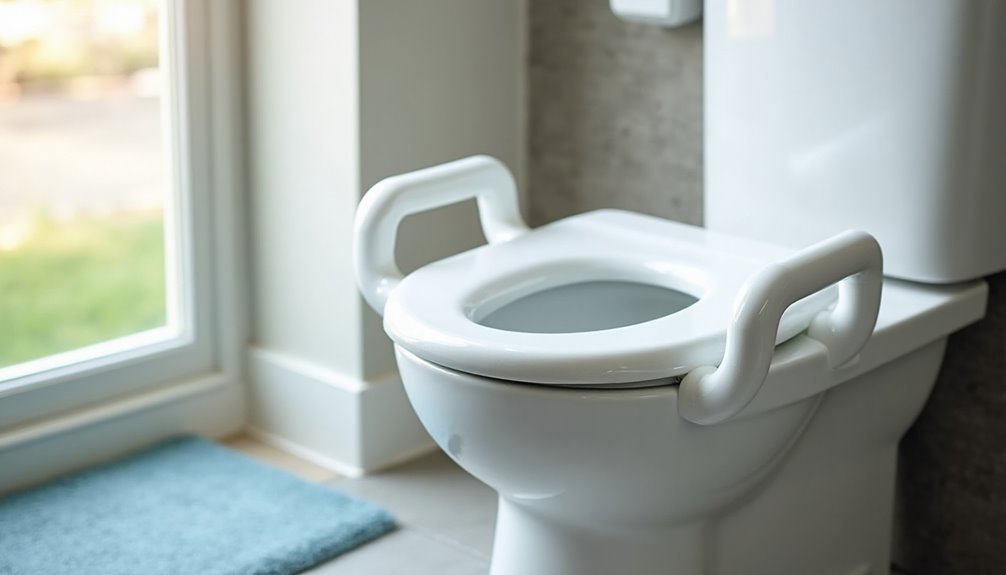
Maintaining your parent’s raised toilet seat properly guarantees longevity of the equipment while providing consistent safety benefits.
Daily cleaning with non-abrasive bathroom cleaners prevents bacteria buildup and maintains hygiene. Simply wipe down the surface, paying special attention to contact points and attachment mechanisms.
Keep your loved one’s raised toilet seat germ-free with gentle daily cleaning, focusing on high-touch areas for maximum safety.
Every week, check all fasteners to ascertain they’re secure. Wobbling is a red flag that requires immediate attention.
For models with padding, inspect for tears or compression that might compromise comfort or safety.
Remove the seat monthly to clean underneath the attachment points. This prevents hidden grime accumulation that can affect stability.
If you notice any cracks, warping, or loose components, replace the seat immediately – never compromise on safety when bathroom falls are among the most common household accidents for seniors.
Safety tips and mistakes to avoid
While installing a raised toilet seat markedly improves bathroom safety for your aging parent, several common mistakes can undermine this investment’s effectiveness.
First, don’t assume one size fits all—measure your toilet dimensions before purchasing to guarantee proper fit.
Never install raised seats on loose or rocking toilets; fix the underlying issue first.
Avoid models that lack secure fastening mechanisms, as these can shift during transfers.
For seniors with limited grip strength, skip designs requiring complex installation or frequent adjustment.
Remember that raised seats with armrests provide better stability than those without.
Finally, maintain vigilance about cleanliness, as missed urine or cleaning solution can create slippery surfaces.
Check all hardware weekly for loosening, and replace any cracked or damaged components immediately—safety issues compound quickly with daily bathroom use.
Alternatives and when not to use this product
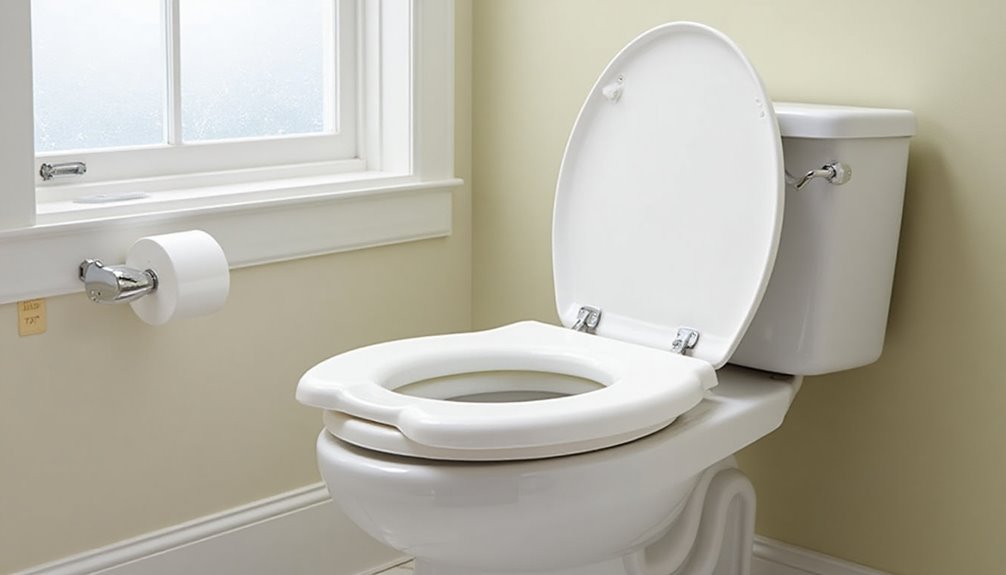
Raised toilet seats work wonderfully for many seniors, but they’re not the right solution for every situation.
While raised toilet seats offer excellent support for many older adults, they aren’t universally appropriate for every senior’s mobility needs.
For those with balance issues or who use walkers, toilet safety frames with handles provide better stability.
Full bathroom remodels with comfort-height toilets offer a permanent solution, eliminating the need for add-on devices.
Avoid raised seats when your loved one needs caregiver assistance for transfers, as these products aren’t designed for two-person use.
Similarly, if mobility issues are severe, a bedside commode might be more practical.
Weight capacity matters too—standard raised seats typically support up to 250-300 pounds.
For heavier individuals, look for bariatric options or consider wall-mounted grab bars paired with a comfort-height toilet instead.
Always consult with an occupational therapist for personalized recommendations based on your parent’s specific needs.
FAQs
Whenever families contact me about raised toilet seats, several questions consistently come up.
Here are the most common ones I address:
“Will it fit any toilet?” Most standard models fit round toilets, but elongated seats require specific versions.
“How much weight can it support?” Typically 250-350 pounds, but bariatric models can support up to 600 pounds.
“Does installation require tools?” Many clip-on models don’t, but bolt-on versions need a screwdriver.
“How do I clean it?” Most can be wiped down with standard bathroom cleaners, but check manufacturer guidelines.
“Will insurance cover it?” Medicare may cover it with a doctor’s prescription as Durable Medical Equipment, but coverage varies by plan and medical necessity.
Frequently Asked Questions
Will Medicare or Insurance Cover the Cost of Raised Toilet Seats?
Medicare typically won’t cover raised toilet seats as they’re considered bathroom safety equipment rather than durable medical equipment.
However, Medicare Advantage plans sometimes offer home safety benefits that might help. Your parent’s private insurance may provide coverage if a doctor prescribes it as medically necessary.
It’s worth calling their specific insurance provider directly, as coverage policies vary considerably between plans.
How Do I Clean Raised Toilet Seats to Prevent Infection?
Cleaning raised toilet seats properly prevents infections and extends their lifespan.
Use antibacterial wipes or mild soap and warm water daily, paying special attention to attachment points and underside areas where moisture collects.
For deeper cleaning weekly, remove the seat (if possible) and disinfect with a bleach solution (1:10 ratio with water).
Always dry thoroughly after cleaning to prevent mold growth.
Never use abrasive cleaners that might create scratches where bacteria can hide.
Can Raised Toilet Seats Be Used With Bidets or Specialty Toilets?
Yes, raised toilet seats can work with bidets and specialty toilets, but compatibility varies.
Traditional bidets usually work fine, while toilet-mounted bidet attachments may need adjustments.
For specialty toilets with unique shapes or built-in features, check measurements first or look for model-specific raised seats.
Smart toilets often require manufacturer-approved accessories.
When purchasing, verify dimensions and attachment mechanisms to guarantee a proper fit and maintain safety features.
What Weight Capacity Do Most Raised Toilet Seats Accommodate?
Most standard raised toilet seats accommodate between 250-300 pounds, but specialized bariatric models can support 400-800+ pounds.
When shopping, always check the manufacturer’s weight rating on the packaging or product description.
For your parents’ safety, I recommend choosing a seat rated at least 50 pounds above their actual weight.
Remember that weight capacity directly impacts stability during transfers, so never compromise on this specification.
Do Raised Toilet Seats Affect the Use of Toilet Paper Holders?
Yes, raised toilet seats can affect toilet paper holder access. Side-mounted holders may become harder to reach as the sitting position changes.
You’ll want to:
1) Measure the distance between your current holder and the raised seat
2) Consider relocating the holder if needed
3) Look for raised seats with built-in dispensers
4) Try freestanding toilet paper stands as an alternative
Many seniors find extending toilet paper holders or reaching aids helpful for maintaining independence.
Bottom Line
You’ve now discovered how raised toilet seats can transform bathroom safety for yourself or a loved one. When properly selected and installed, these devices greatly reduce fall risks and joint strain during transfers. Remember to evaluate height, stability, and bathroom layout when making your choice. With regular cleaning and proper use, your raised toilet seat will provide lasting independence and comfort in your daily routine.

